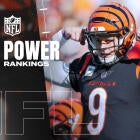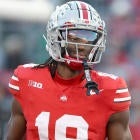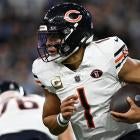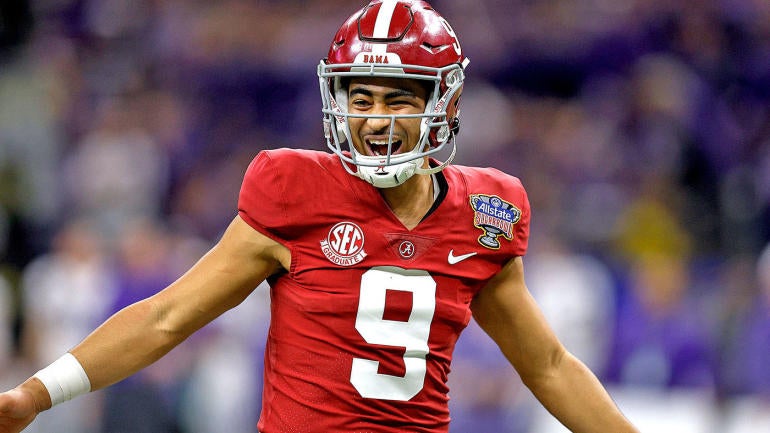
The Panthers will kick off the 2023 NFL Draft on Thursday night answering arguably the biggest question of the entire event: which quarterback to take No. 1 overall? New coach Frank Reich has teased Florida's Anthony Richardson as an all-world talent, but all signs point to Carolina deciding between the consensus top two signal-callers of the class: Alabama's Bryce Young and Ohio State's C.J. Stroud.
Both QBs have drawn rave reviews in the pre-draft process. Stroud is widely considered the top pocket passer among 2023 prospects, boasting prototypical size for the position. Young, meanwhile, has a smaller, slender stature but possesses all the poise and vision of a No. 1 pick. In some eyes, the Panthers shouldn't go wrong no matter which QB they select.
But what about the track record of QBs from the schools that produced Stroud and Young? How have Alabama and Ohio State products tended to fare under center at the NFL level? Obviously, past prospects cannot fully predict how individual players with separate talents will develop. Justin Herbert is a prime example; Oregon had a prominent history of NFL QB busts prior to his explosive entry as the face of the Chargers.
But if you're wondering which of Stroud or Young hails from a more proven line of recent college-turned-pro QBs, we've surveyed the last 30 years of Alabama and Ohio State passers to be drafted to the NFL:
For more draft content, check out our latest prospect rankings and mock drafts, as well as our new weekly podcast, "With the First Pick," featuring former Vikings general manager Rick Spielman. (Check out the latest episode below.)
Alabama
Note: * = player transferred to Oklahoma for final collegiate season.
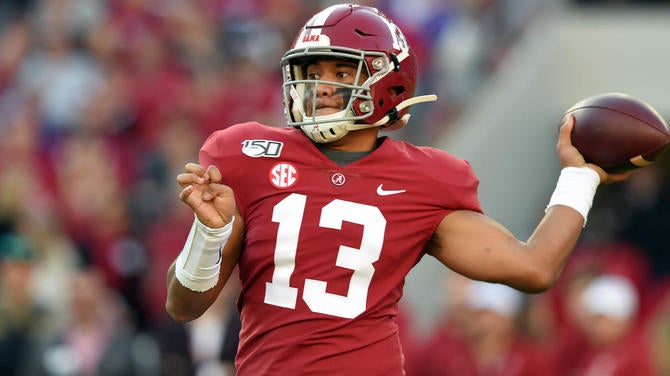
| Year | QB | Drafted | Team | Years | Starts (Record) | Pro Bowls |
|---|---|---|---|---|---|---|
2021 | Mac Jones | 1 (15) | 2+ | 31 (16-15) | 1 | |
2020 | Tua Tagovailoa | 1 (5) | 3+ | 34 (21-13) | 0 | |
| 2020 | Jalen Hurts* | 2 (53) | Eagles | 3+ | 34 (23-11) | 1 |
2014 | A.J. McCarron | 5 (164) | 4 | 3 (2-1) | 0 | |
2011 | Greg McElroy | 7 (208) | 2 | 1 (0-1) | 0 | |
2006 | Brodie Croyle | 3 (85) | 5 | 10 (0-10) | 0 | |
1995 | Jay Barker | 5 (160) | 1 | N/A | 0 |
Ohio State
Note: * = selected via the NFL's supplemental draft, for players ineligible for the traditional draft
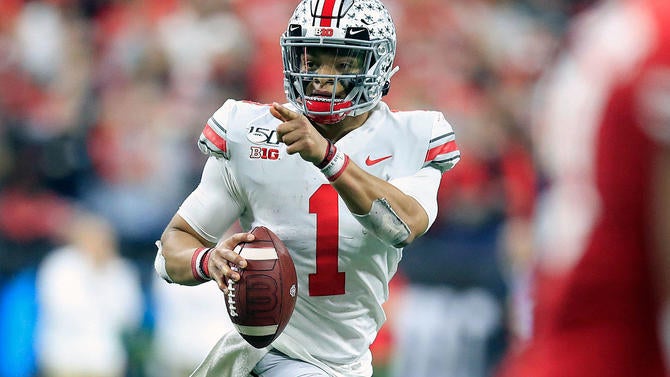
| Year | QB | Drafted | Team | Years | Starts (Record) | Pro Bowls |
|---|---|---|---|---|---|---|
2021 | 1 (11) | 2+ | 25 (5-20) | 0 | ||
2019 | Dwayne Haskins | 1 (15) | Washington | 3 | 13 (3-10) | 0 |
2016 | 4 (139) | 1 | N/A | 0 | ||
2011 | 3* | 3 | 10 (3-7) | 0 | ||
2007 | Troy Smith | 5 (174) | 3 | 2 (1-1) | 0 | |
2004 | Craig Krenzel | 5 (148) | Bears | 1 | 5 (3-2) | 0 |
2002 | Steve Bellisari | 6 (205) | 0 | N/A | 0 | |
| 1999 | Joe Germaine | 4 (101) | Rams | 2 | N/A | 0 |
| 1996 | Bobby Hoying | 3 (85) | Eagles | 3 | 13 (3-9-1) | 0 |
Takeaways
So how do the two schools stack up, if you're using their results as any kind of influence on the Stroud versus Young debate? Let's start with quantity: since 1993, Ohio State has produced slightly more NFL QBs through the draft, with nine selections as opposed to Alabama's six (seven including Hurts, who spent the first three years of his college career with the Crimson Tide but was officially drafted out of Oklahoma). That said, Alabama's drafted QBs have seen the field more at the NFL level, totaling 79 starts to Ohio State's 68. If Hurts is included, the disparity is even more apparent: 113 Alabama starts to Ohio State's 68.
Which school is winning more in the NFL? Drafted Alabama QBs have gone a combined 39-51 (or, with Hurts, 60-62). Not great, perhaps, but it's a far uglier number with the Buckeyes, who've gone just 18-49-1. Wins and losses are of course a team record, not an indictment solely of the QB; Justin Fields, for example, was an MVP-caliber rushing threat for Chicago in 2022, but the Bears stumbled to a 3-14 finish in large part because they refused to surround the young QB with even average protection or weapons. Even so, Alabama has the edge on the whole, despite sending three fewer QBs to the NFL via the draft.
It's worth noting that both Alabama and Ohio State have only recently produced multiple multi-year starters. Between 1993 and 2018, a span of 25 years, only a single drafted QB from either program started more than 10 games for his NFL career -- the Eagles' Bobby Hoying, who went 3-9-1 before Philadelphia replaced him with Syracuse's Donovan McNabb. That means almost all of the most accomplished QBs here are still active: Fields is theoretically primed for a major step forward after the Bears' spendy offseason, while Jones and Tagovailoa have helped shepherd playoff bids in the AFC East. Hurts is an asterisk inclusion, but he's currently one of the top QBs in the NFL after an MVP and Super Bowl bid in 2022.
So who's the real winner here? If we strike Hurts from the conversation, Alabama probably gets a slight nod. Fields offers more athletic upside than both Jones and Tagovailoa, the Crimson Tide's best official bets for contemporary NFL stardom, but Alabama's QBs have still made a more noticeable impact as of late. If we extend the survey, including all-time draft results, then Alabama wins in a landslide. Between 1956-1968, the Crimson Tide sent the following three QBs to the NFL via the draft: Bart Starr (1956), who played 16 seasons with the Packers, winning two Super Bowls and five total championships as one of the best to man the position; Joe Namath (1965), who won Super Bowl III MVP during a 12-year run as the face of the Jets; and Ken Stabler (1968), a four-time Pro Bowler who won NFL MVP and Super Bowl XI during a 10-year stint with the Raiders.
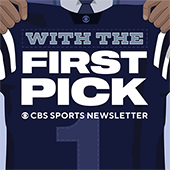
With The First Pick Newsletter
With The First Pick Newsletter
Prepare for the upcoming NFL Draft with the day’s big stories + mock drafts, big board updates and more.















